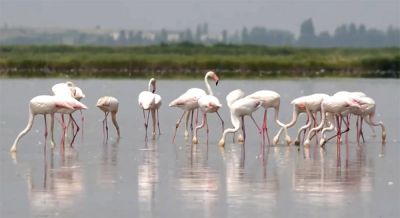An unusual pest is ravaging crops and angering farmers in northeastern Italy. Flamingos. Flocks of these relatively recent birds have set their hungry sights on the flooded fields that produce rice for risotto in the Ferrara province, between Venice and Ravenna. Flamingos use their webbed feet to stir up the soil and snatch mollusks, algae or insects from the shallow water. The rice crop is collateral damage. Farmers have started patrolling day and night in a bid to scare the birds away. The flamingos appear to have come from their prior nesting grounds in the nearby Comacchio Valleys within a reserve on the coast, just south of where the Po River, Italy’s longest, flows into the Adriatic Sea. The birds have been there since 2000, after drought in southern Spain sent them searching for nesting grounds further east, according to Roberto Tinarelli, ornithologist and president of the Emilia-Romagna Ornithologists Association, as reported by the AP.
I contadini del nord-est Italia, in particolare nella provincia di Ferrara, tra Venezia e Ravenna, si trovano ad affrontare un problema unico: la sovrappopolazione di fenicotteri. I fenicotteri hanno invaso quest'area perché, con l'attuale alluvione, c’è molto da nutrirsi. Ad esempio, usano i loro piedi palmati per scavare la terra e trovare molluschi, alghe e/o insetti che vivono in questa zona paludosa. Quest'area, tuttavia, è dove i contadini coltivano l'unico riso utilizzato per preparare il risotto. I contadini devono costantemente vigilare la terra per spaventare i fenicotteri. Credono che i fenicotteri siano migrati dalle Valli di Comacchio, sulla costa Adriatica dove il Fiume Po sfocia nel mare. Secondo Roberto Tinarelli, ornitologo e presidente dell'Associazione Ornitologica dell'Emilia-Romagna, i fenicotteri arrivarono nel 2000 quando la Spagna ebbe una grave siccità. Gli uccelli volarono verso est per trovare un posto migliore in cui vivere e fare i nidi.



